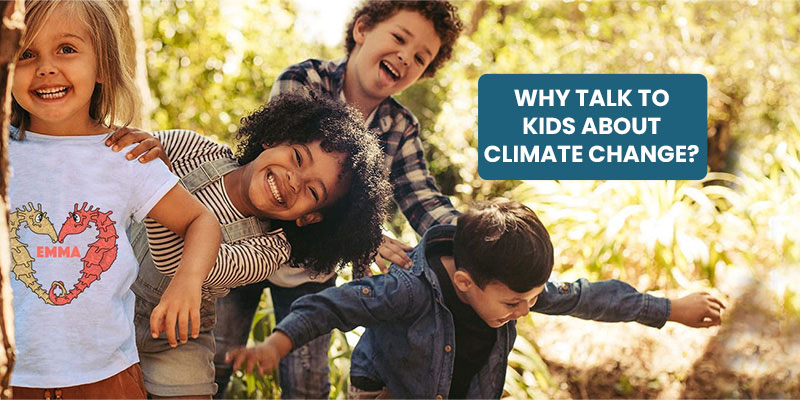More kids than ever are worried about climate change and plastic pollution today. They are armed with facts and more eager to do something about it than many adults we know. Yet, our youngest, most earnest and curious citizens — kids between ages 4-10 — are often left out of the climate change conversation. These kids will not only face the worst consequences of climate change and plastic pollution, they will also be the leaders of tomorrow.
In order to address the long-term challenges of climate change, we must include, educate and empower our elementary school children as they are a uniquely influential and untapped audience. Here are five reasons why kids need climate change Conversation:
KIDS HAVE AN INNATE LOVE FOR NATURE AND WE MUST NURTURE IT
Being with nature has a plethora of benefits. It teaches important lessons about our interconnectedness and dependence on the living planet. It helps kids be more creative, ingenuities and better problem solvers.
Studies have also shown that kids who spend time in nature are more likely to conserve and advocate for nature as adults. Famous conservationists Sir David Attenborough and Jane Goodall have attributed their passion for our planet to their “nature memories” from childhood.
While the digital world has become an integral part of our kids’ lives, we have the opportunity to harness a child’s innate love for the outdoors to create nature memories at a young age. And thereby, instill a sense of empathy for and responsibility towards the planet at a young age.
BUILDING POSITIVE ECO HABITS IS EASIER WHEN YOU’RE YOUNG
As adults, we’re constantly grappling with trying to replace old habits with mindful behaviors. Now that we know the impact of our actions, what if we could instill planet-friendly eco habits, right from the start?
A Brown University study found that routines and habits take root in children by the age of 9.
Alongside other life skills, we must encourage curiosity in our children and teach them to ask more probing questions. Questions about how stuff is made and where their food comes from. Questions about the social and environmental cost of their toys. And because plastic and climate change are inextricably linked, what if we opened their eyes to the impact of plastic in the ocean and modeled a life without single-use plastic?
Inculcating age-appropriate eco behaviors right from the start would not only teach them to live a less wasteful life but also deepen their awareness and understanding of the impact of their choices.
KIDS ARE POWERFUL AGENTS OF CHANGE, ESPECIALLY AT HOME
When was the last time that your child corrected something you said or did? Children are one of the biggest influences in fostering behavior change among parents, including raising their concerns about climate change.
The ability for kids to influence their parent’s purchase decisions, i.e. “Kidfluence” is a real thing. From toys and games to shoes and clothes, 87% of parents from a 2019 study said that their kids have a strong influence over what their parents buy.
Now, just imagine the long-term impact of their purchasing power if they knew the social and environmental impact of their toys, clothes and games!
PARENTS WANT THEIR KIDS TO LEARN ABOUT CLIMATE CHANGE CONVERSATION
NPR/Ipsos found in a 2019 poll that most teachers don’t teach about climate change, but four in five parents wish they did. And less than half of the parents said they had talked to their own kids about it at home. (Most probably because they didn’t know how to have this conversation.)
Conversations with kids about the state of the environment and helping them to understand their role in protecting it, can and should start in the home. While these chats can feel daunting at first, they don’t need to be when you’re speaking with young children. This brings me to my last, but most important point.
KIDS LEARN THROUGH STORIES, MAKE IT PERSONAL
A recent study from the University of Bath found that storytelling was the most effective way of teaching primary school children about evolution, a complex topic. The same goes for climate change. Climate chats with younger children don’t need to be riddled with doomsday facts and stats. Instead they can be fun stories rooted in empathy, courage and imagination. Bonus if their favorite animals are thrown in!
What’s more, kids, even babies as young as 3 months old, understand the difference between good and bad. Kids are born with a hard-wired morality and it doesn’t take much to convince them; they will save their animal friends or rainforests simply because it’s the right thing to do!
As a parent, grandparent or caregiver, you don’t need to be a climate expert. Turn basic facts into emotional stories about turtles who confuse plastic bags for their favorite food, jellyfish of course. Or polar bears looking for a new home due to melting ice. Better yet, make it personal and draw inspiration from your childhood and describe the memories you’ve built with nature. You’d be surprised by the interest you’ll garner and the climate change conversations that follow.
There is no doubt that in order to combat climate change, we need better government policies. But I would argue that we also need a generation of thoughtful leaders who will make healthy decisions for us and our planet.
The children of today will be those leaders. And for the sake of their survival and the rich biodiversity and wildlife that inhabits our earth, we’d better raise them with the right eco values to give us all a fighting chance.
As parents, it is our responsibility to not only leave a better planet for our kids, but also raise better kids for our planet.
Anu Ramamurty is a mum, climate campaigner and founder of Kat Kid Adventure, a mission-driven lifestyle brand for kids. Kat Kid Adventure creates eco-products and workshops that tell stories about climate change and empower families to take action. Visit www.katkidadventure.com


